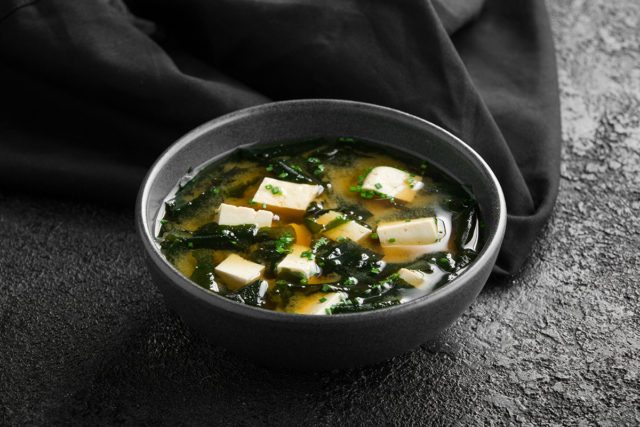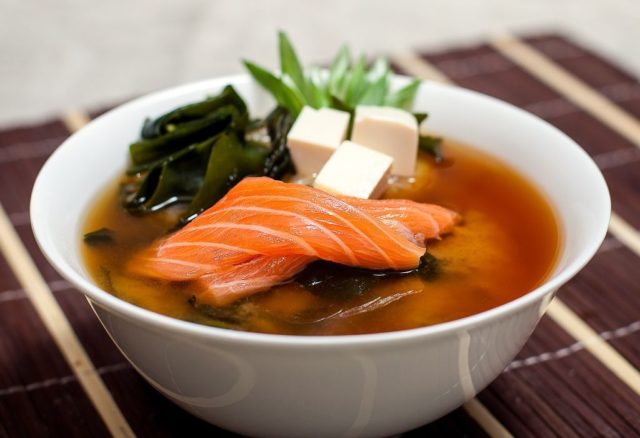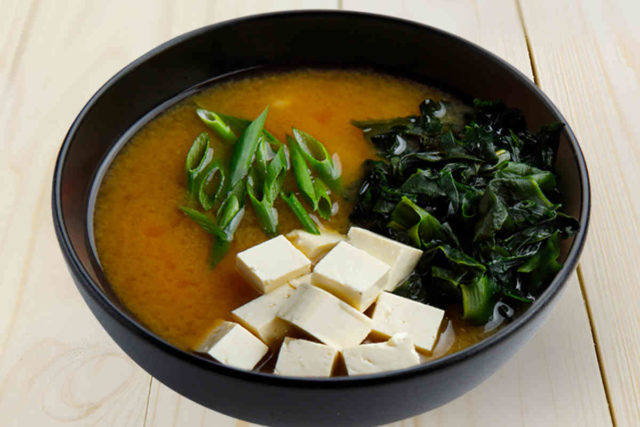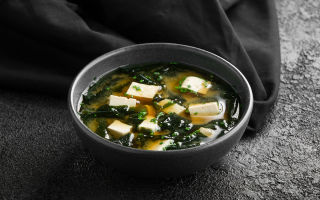Content
Miso soup is a Japanese dish made with tofu cheese and dashi fish broth. It got its distribution 750 years ago, during the time of the samurai. The soup is made using a special technology using a certain set of ingredients. It is appreciated for its exotic taste and low calorie content.
What is miso
Miso is a traditional Japanese fermented product with a pasty consistency. It is made from soybeans. The paste has a reddish or yellowish tint and a rich fishy taste. It is used in soups, marinades, pickles and sauces. In Japan, miso is credited with many beneficial properties. The product contains many vitamins and minerals.
It is miso pasta that is an indispensable ingredient in the soup of the same name. It gives the dish an exotic salty flavor. Some types of pasta have a sweet hue, so they are used as a dessert.
How miso paste is made
Miso paste can be found at any Japanese store. It comes in small cans or bags. If desired, the pasta can also be prepared at home. Its consistency, flavor and color will depend on the ingredients used. The preparation process involves the fermentation of the original fermented substrate. It can be soybeans, wheat or rice. The duration of fermentation can vary from 3 months to 3 years.
Light miso paste is made from wheat and white rice. It has a more neutral flavor, with a slight sweetness. Dark miso paste is used to make marinade and soup. It has a rich salty taste.

Composition and calorie content
The benefits and harms of miso paste are a common subject of discussion and controversy. Supporters of a healthy lifestyle are especially concerned about its calorie content. There are 197 kcal per 100 g of product. That is why it does not contribute to weight gain. Miso paste contains the following beneficial substances:
- sodium;
- protein;
- zinc;
- manganese;
- vitamins of groups A, C, PP, E, K and D;
- calcium;
- iron;
- fatty acid;
- selenium;
- copper;
- amino acids;
- iodine.
Due to the abundance of vitamins in the composition, the dish has a positive effect on the immune system and reduces the risk of developing colds. Minerals improve blood composition and have a positive effect on the nervous and cardiovascular systems. The fatty acids present in the composition improve the appearance of the skin. The protein component ensures the correct formation of the muscle corset.
Is miso soup good for you?
Due to its rich composition, miso soup is very beneficial for human health. Despite its low calorie content, it contains a sufficient amount of protein, which is the main building block. The Japanese consider miso soup to be a dish of health and longevity. It helps in weight loss and has a beneficial effect on the immune system.Due to the presence of lactobacilli and lactic acid bacteria in the composition, the work of the digestive system is regulated. The beneficial properties of miso soup also include:
- prevention of osteoporosis;
- slowing down the aging process;
- strengthening the walls of blood vessels;
- lowering the level of bad cholesterol;
- normalization of the central nervous system;
- reducing the risk of developing malignant tumors;
- detoxification of the body;
- improving skin condition;
- regulation of metabolism;
- strengthening the immune system;
- improving the emotional state.
Thanks to the algae, Japanese soup is the richest source of iodine. With its use, the work of the endocrine system is normalized, which affects the hormonal background. Due to the content of amino acids, metabolic processes are regulated. The antioxidant properties of the dish help to strengthen the immune system and protect the body from the harmful effects of the environment.
How to make miso soup
There are several options for making Japanese soup. Each of them involves the use of a specific set of ingredients. In order for the finished dish to meet expectations, each component must be added in order of priority.
Traditional recipe
Components:
- 8 shiitake mushrooms;
- 1 tsp dry dasha broth;
- 100 g tofu;
- 100 g miso paste;
- 1 tbsp. l. wakame seaweed;
- soy sauce to taste.
Cooking steps:
- Soak wakame seaweed in water in a separate container.
- Mushrooms and cheese are cut into small cubes.
- Water is poured into a saucepan and brought to a boil. Then dashis are dissolved in it.
- Put miso paste in the finished broth and slightly heat the contents of the pan, without bringing to a boil.
- Algae, mushrooms and tofu are spread in a deep plate in the right amount. Top the ingredients with hot broth. The soy sauce is added directly to the cup.

Salmon miso soup
Ingredients:
- 60 g tofu;
- 300 g fresh salmon;
- 1 liter of water;
- 60 g miso paste;
- ½ tbsp. l. dry algae;
- 1 tbsp. l. soy sauce;
- 1 tsp dasha broth.
- sesame seeds, green onions - to taste.
Recipe:
- The algae are soaked in water.
- Water is poured into a saucepan and put on fire. After boiling, dashi sauce is poured into it.
- Next, pieces of salmon are dipped into the water and soy sauce is poured.
- After 3 minutes of boiling, chopped tofu cubes and seaweed are added to the soup.
- The next step is to add miso paste to the dish. Mix everything thoroughly.
- After the soup is poured into bowls, it is garnished with green onions and sesame seeds.

Miso soup with vegetables
Components:
- 1.25 l of dasha broth;
- 5 champignons;
- 1 carrot;
- 3 tbsp. l. dark miso paste;
- a bunch of spinach;
- 3 green onion feathers;
- 120 g tofu;
- ½ tbsp. corn;
- 100 g of green peas.
Cooking steps:
- Peel and cut the carrots into strips.
- Mushrooms are chopped into thin slices.
- The peas are cut into long strips and the green onions are cut into rings.
- The spinach should be rinsed thoroughly and the tough part trimmed. Then the leaves must be torn into 2-3 pieces.
- Pour water into a saucepan and bring to a boil. Miso paste is dissolved in the resulting broth.
- Corn, mushrooms and carrots are thrown into the pan. After 3 minutes, add the rest of the ingredients.
- The soup is boiled over low heat for another 5 minutes.
- 5 minutes before cooking, put finely chopped tofu cubes in a saucepan.

Contraindications and possible harm
Despite the fact that miso soup contains a lot of useful substances, not everyone is allowed to eat it. Contraindications for meals include:
- high blood viscosity;
- disruption of the thyroid gland;
- kidney disease;
- exacerbation of chronic gastrointestinal diseases;
- intolerance to beans.
There is a lot of salt in Japanese soup. If consumed excessively, it can cause swelling. That is why the dish is not recommended for people with kidney disease. It should also be remembered that the composition contains potential allergens that can provoke unwanted body reactions.
Is miso soup for dinner harmful or not?
Soups are more suitable for consumption at lunchtime. But nutritionists do not prohibit eating them for dinner. Since the dish is low in calories, it will not affect the figure. But you need to understand that excessive salt content provokes fluid retention in the body. This leads to the appearance of edema in the morning.
How to choose and store miso paste
When choosing Japanese pasta in a store, you should pay attention to its composition and appearance. A dark product is suitable for making soup. It is important that the composition is free of dyes and flavorings. It is advisable to make a purchase in specialized stores of Japanese goods. Store the opened paste in the refrigerator, taking into account the expiration date on the package. It is important to avoid contact of the product with air and high temperatures.
Conclusion
Miso soup is considered an extremely tasty and healthy dish. The substances in its composition activate the immune system, and the protein helps to build muscle. But, despite the benefits, the dish should be eaten with extreme caution.

